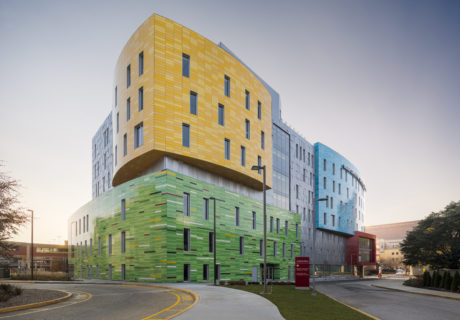Celebrating The Great Outdoors At Sunshine Coast University Hospital
During the design of Sunshine Coast University Hospital, a 450-bed tertiary teaching hospital serving Australia’s Sunshine Coast and Gympie regions, the project team embraced a holistic philosophy that put as much emphasis on the outside areas, including visual and physical access to the outdoors and landscaped spaces, as they did the indoor spaces to facilitate the healing process.
“The Sunshine Coast’s pristine landscape was a key inspiration for the project’s design,” says Martin Wilshire, design manager, Place Design Group (Birtinya, Australia), which served as the landscape architect and design consultant on the project working with builder Lendlease, architecture firms HDR, Architectus, and engineering firm Aurecon. “The landscape architecture is a key element in the healing focus of the hospital’s design, with numerous areas for gathering and quiet contemplation set within lush sub-tropical plantings.”
The hospital, which opened in April 2017 by the Queensland Premier and Minister for Health and Minister for Ambulance Services, features multiple courtyards, rooftop gardens, and rest areas. Specific design goals were outlined for each outdoor area based on the proposed user and the required function of the spaces.
“This was a requirement of the project and was aimed at creating a holistic healing environment in which most patients and departments had access to an external space to facilitate the healing process,” Wilshire says. Place Design Group used Revit to model spaces in 3D to help integrate with the architects and the façade design, as well as for review by the client and user groups.
The public central courtyard, located on the ground level adjacent to the internal hospital street and near the main hospital entrance, is designed to create an inviting outdoor respite area for hospital visitors, staff, and patients. Several upper courtyards are linked to specific departments, such as paediatrics and maternity.
A rehabilitation mobility courtyard on Level 5 incorporates different walking surfaces, such as paving, decking, gravel, sand, steppers, and synthetic grass, as well as everyday elements including a clothes line, pool gate, steps, handrails, ramps, bus step, swinging door, and sliding door. The ground level of the mental health unit houses four internal and three external courtyards.
Another aspect of the project was the incorporation of public artworks by Lubi Thomas and Adrian Davis, titled “Kin” and “Kindred,” located within the central courtyard and positioned in consideration of sightlines from the cancer care waiting room area.
“The artworks were incorporated into the landscape design to reflect upon the ancient local landscape and flora, cycles of time, and rituals of the community,” Wilshire says.









